rev., Jun 26, 2020.
This is segment 1 of a 3-part posting of Part 1 of a larger treatment of the movie. Included in The Horror of…..Manson (2020, unpubl.)
There is a reason why, in the last shot, Once Upon a time…in Hollywood (2019) ends with the fairy tale words that usually go at the beginning. Since, in fact, James Joyce’s Finnegan’s Wake (1939) there has been a small tradition of movies that end with the beginning. It is also true that in all horror movies, which this is most definitely not, the movie always ends with a shot of the horror or the monster likely to return, to generate sequels, with the “to be continued” trope; but, in the context of the movies, the story will always be spun again, and again, and again, that is, monsters never die. So it is here.
 Most people most of the time in our rationalistic modern society read movies as filmed fictions of events that are, in the fictive space, real. That is, we see the movie, we accept that it is a fiction, but when it settles into its middle fictive space, the storytelling space, that is a “reality” which we momentarily suspend our disbelief of, and go along.
Most people most of the time in our rationalistic modern society read movies as filmed fictions of events that are, in the fictive space, real. That is, we see the movie, we accept that it is a fiction, but when it settles into its middle fictive space, the storytelling space, that is a “reality” which we momentarily suspend our disbelief of, and go along.
 that is, though the frontal space is more likely than in previous eras of movies to come forward to engage us with effects, we still, as rational audiences, want to go into the fictive space in the movie, settle in, then make a pact with the cult image or truth behind the movie, then think, ok, so everything now is “real” in that space. No Country for Old Men (2010), for example, once we get into it, we are in it, a man hunt for a serial killer in Texas. Certainly, therefore, it is 100% guaranteed that at least 95% of the audience even for a Quentin Tarantino movie like Once Upon a Time…. (2019) will want to view the movie as a fictional biopic of the events in the life of a struggling actor over the hill, Ric dalton, in the year of Hollywood’s big change, the new era symbolized by Sharon Tate. This is how I first watched the movie, for that reason, I found the fantasy ending quite problematical. But, now, having mulled it over, based on the magic of a second viewing, I begin to see some deeper underlying logic.
that is, though the frontal space is more likely than in previous eras of movies to come forward to engage us with effects, we still, as rational audiences, want to go into the fictive space in the movie, settle in, then make a pact with the cult image or truth behind the movie, then think, ok, so everything now is “real” in that space. No Country for Old Men (2010), for example, once we get into it, we are in it, a man hunt for a serial killer in Texas. Certainly, therefore, it is 100% guaranteed that at least 95% of the audience even for a Quentin Tarantino movie like Once Upon a Time…. (2019) will want to view the movie as a fictional biopic of the events in the life of a struggling actor over the hill, Ric dalton, in the year of Hollywood’s big change, the new era symbolized by Sharon Tate. This is how I first watched the movie, for that reason, I found the fantasy ending quite problematical. But, now, having mulled it over, based on the magic of a second viewing, I begin to see some deeper underlying logic.
Still, in viewing the movie, one might be fair to wonder why is Tarantino constantly shifting from one temporal POV to another, why can’t he just leave the movie in the present of the movie, 1969, and stop going into other movies, or whatever? Worse, he goes into the other medium for just long enough for us to then try to settle and get comfy there, then he bounces us out. In fact, I got this. This is a hypnagogic device, which alerts me to the fact that the movie is to be viewed under the influence of the Big Sleep, that is, the devices of hypnagogy are utilized to make a depiction of conscious life more interesting. And a zone in hypnagogy, high up in the Land of Nod, just as, in fact, like Bruce dern, who is simply sleeping between movies, is a place I term the Village of dreams.
 The Village of dreams (I call it a village because it is usually pictured as a village) is simply the formations and sights in a shallow stage of the entoptic first phase of hypnagogy, as one drifts off to sleep, and it’s primary characteristic is that it is constantly nodding in and nodding out, almost as per the camera clicks, it is moving from dream to reality (in the example I give often, Anna Lui’s The Spooky Bunch (1981, Hong Kong) it is a ramshackle backstage carnival place where you don’t know, from shot to shot, who is real and who is a ghost), from falling asleep to waking back up, and as such it has a lightning like visual experience form, as such.
The Village of dreams (I call it a village because it is usually pictured as a village) is simply the formations and sights in a shallow stage of the entoptic first phase of hypnagogy, as one drifts off to sleep, and it’s primary characteristic is that it is constantly nodding in and nodding out, almost as per the camera clicks, it is moving from dream to reality (in the example I give often, Anna Lui’s The Spooky Bunch (1981, Hong Kong) it is a ramshackle backstage carnival place where you don’t know, from shot to shot, who is real and who is a ghost), from falling asleep to waking back up, and as such it has a lightning like visual experience form, as such.

It is part and parcel that Spahn Ranch is the ultimate village of dreams formation, as, as I studied it last summer, it has a long and quite seedy history as a site of b-movie production. The whole sequence where Cliff goes out to it is pocked with time-skips by way of generational misunderstandings. First, there is the Manson girl in the car, who characterizes Cliff as really old.
 he is amused, you mean eight years ago? so, from now, for example, that would be 2012.
he is amused, you mean eight years ago? so, from now, for example, that would be 2012.
 then they have a wobble-wobble over her sexual come-on, and, no doubt because of his “history” saying I’m not going to prison for some poontang, is you’re 17 if you’re a day.
then they have a wobble-wobble over her sexual come-on, and, no doubt because of his “history” saying I’m not going to prison for some poontang, is you’re 17 if you’re a day.
 then when he gets to the place, Charlie is not there, so this is not prime time Charlie movie (an odd decision) but he is confused, now a cult is living there, he wonders if his old friend George is ok, so he knows where he lives, and he’s going in, regardless of their paranoia against outsiders.
then when he gets to the place, Charlie is not there, so this is not prime time Charlie movie (an odd decision) but he is confused, now a cult is living there, he wonders if his old friend George is ok, so he knows where he lives, and he’s going in, regardless of their paranoia against outsiders.
 inside the parlor of George’s house, there are one, two, three, four, five, six, maybe seven wobbles in time. They are, George’s western sculpture; the black and white tv showing the Monkees; the black and white TV sitting on top of the color tv because the color tv, all posh in 1964, obviously got broken; the western gear to the left; then, most interesting, the bare feet of the watchers, I count ten toe cleavages. Thus, this room is a composite in time of 1954, 1964, 1969, 1953 (when the kids were born), then the toes are doing the counting up of time passing. (if you do not recognize the Monkees, then I would liken this shot to Lewis-Williams’ analysis of San rock art using neurological structures, that is, the center is invisible, but then a buzz or frisson around the edge is evoked by the wobble-wobble of a bunch of animal legs only, so, here, toes only (it comes up elsewhere in the movie too, indeed, the most we saw of the hippie girl, communicating her unwashed state to Cliff, was the bottoms of her feet).
inside the parlor of George’s house, there are one, two, three, four, five, six, maybe seven wobbles in time. They are, George’s western sculpture; the black and white tv showing the Monkees; the black and white TV sitting on top of the color tv because the color tv, all posh in 1964, obviously got broken; the western gear to the left; then, most interesting, the bare feet of the watchers, I count ten toe cleavages. Thus, this room is a composite in time of 1954, 1964, 1969, 1953 (when the kids were born), then the toes are doing the counting up of time passing. (if you do not recognize the Monkees, then I would liken this shot to Lewis-Williams’ analysis of San rock art using neurological structures, that is, the center is invisible, but then a buzz or frisson around the edge is evoked by the wobble-wobble of a bunch of animal legs only, so, here, toes only (it comes up elsewhere in the movie too, indeed, the most we saw of the hippie girl, communicating her unwashed state to Cliff, was the bottoms of her feet).
 the bit lip indicates to her that not only is it always a problem when an outsider comes into their ensconcement, but if there is trouble she will get blamed for it.
the bit lip indicates to her that not only is it always a problem when an outsider comes into their ensconcement, but if there is trouble she will get blamed for it.
 but, back inside, wise-ass red-haired girl settles back down as if she does not care, but her report on George is encouraging, and surprising, he’s in back sleeping, because he’s 80, and “I fucked his brains out this morning,” so good for him, though one still suspects exploitation. The fun part of the shot to me is that there is a split lamp, a great property, bespeaking talking at cross purposes, it also seems, from the time when the whole Western thing was going to seed, a ukulele lodged in between the shades, and you know from Joker (2019), I think ukeleles bespeak a song from another state of mind.
but, back inside, wise-ass red-haired girl settles back down as if she does not care, but her report on George is encouraging, and surprising, he’s in back sleeping, because he’s 80, and “I fucked his brains out this morning,” so good for him, though one still suspects exploitation. The fun part of the shot to me is that there is a split lamp, a great property, bespeaking talking at cross purposes, it also seems, from the time when the whole Western thing was going to seed, a ukulele lodged in between the shades, and you know from Joker (2019), I think ukeleles bespeak a song from another state of mind.
 as such
as such
 then he goes back in, and this part of the house appears to be another time zone, almost like in a horror movie, because entering into it are guardian guides in the form of later-put-up afterthought reinforcement images of old cowboy hero black and white photos torn from fan magazines and pinned to the wall, as a fan would.
then he goes back in, and this part of the house appears to be another time zone, almost like in a horror movie, because entering into it are guardian guides in the form of later-put-up afterthought reinforcement images of old cowboy hero black and white photos torn from fan magazines and pinned to the wall, as a fan would.
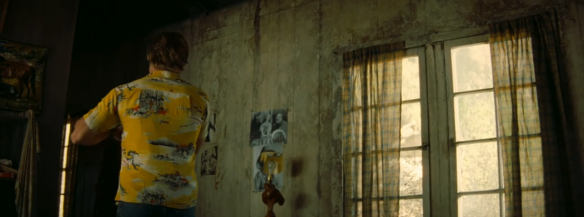 there, hidden, are three phantoms from my childhood, Zorro, the Lone Ranger and Tonto.
there, hidden, are three phantoms from my childhood, Zorro, the Lone Ranger and Tonto.
 the horse of nightmare makes him worry, coming in, finding George heaped in a corner, he could just as likely’ve’been dead
the horse of nightmare makes him worry, coming in, finding George heaped in a corner, he could just as likely’ve’been dead
 but, while it’s not perfect, with the rats too, it’s ok enough for Cliff to leave it be
but, while it’s not perfect, with the rats too, it’s ok enough for Cliff to leave it be
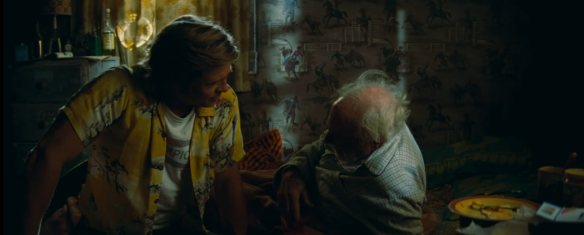 though I am enough of a trope collector to out-Tarantino Tarantino, to wonder if that wallpaper isn’t the same as in the bedroom in the original Amityville Horror movie, and forebodes ill for George.
though I am enough of a trope collector to out-Tarantino Tarantino, to wonder if that wallpaper isn’t the same as in the bedroom in the original Amityville Horror movie, and forebodes ill for George.
 then as Cliff leaves, apart from the flat tire part, there is one more wobble, when the girls think Tex needs to be called, to secure the place from an intrusion, so he rides in like the cavalry, to save the day, but he is too late.
then as Cliff leaves, apart from the flat tire part, there is one more wobble, when the girls think Tex needs to be called, to secure the place from an intrusion, so he rides in like the cavalry, to save the day, but he is too late.
 this is a larger wobble-wobble effect. He is squarely, as a person, in 1969, doing tours for tourists of the canyon; but, in this movie, he is reawakening the period of Spahn ranch, when, in fact, it hosted scenes like this, in westerns in the 1950s, so it is a wobble to that time; then, too, this whole sequence is counterpointed, a bit too bluntly, with an immediately preceding scene in which Rick acting on the set in a Western town does his scene. So, duel at High Noon on a Hollywood soundstage is contrasted with a difficulty in aftertime at a former soundstage, now to host an even more horrific form of Western carnage, Charlie’s plan for Helter Skelter.
this is a larger wobble-wobble effect. He is squarely, as a person, in 1969, doing tours for tourists of the canyon; but, in this movie, he is reawakening the period of Spahn ranch, when, in fact, it hosted scenes like this, in westerns in the 1950s, so it is a wobble to that time; then, too, this whole sequence is counterpointed, a bit too bluntly, with an immediately preceding scene in which Rick acting on the set in a Western town does his scene. So, duel at High Noon on a Hollywood soundstage is contrasted with a difficulty in aftertime at a former soundstage, now to host an even more horrific form of Western carnage, Charlie’s plan for Helter Skelter.
The movie in fact, plays with the wobble when we move from Rick acting to Cliff checking things out, when Rick comes in from berating himself in his trailer, to get back onto set, there is a shift in scenery that in my purest postmodern days, I would’ve exulted in, moving from a reality to a simulation of another reality, in that reality. It really does still tingle, when we see him walking from off to on set, and filmed in a way that increasingly focuses on it being him in the movie in the movie, and not just in this movie.
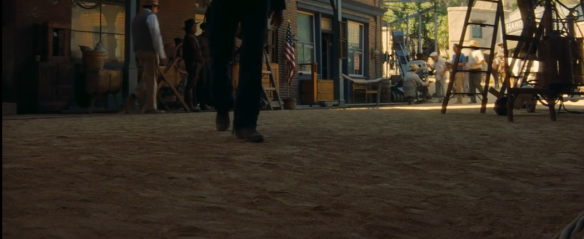 when he comes up the stairs of the saloon, and the legs of a modern staffer young woman come down past him, that’s the nexus point, where you are between, where things tingle.
when he comes up the stairs of the saloon, and the legs of a modern staffer young woman come down past him, that’s the nexus point, where you are between, where things tingle.
 but, then, the “fun” thing is that once the movie in the movie begins to shoot, Tarantino pulls his camera back so that it equates with their camera and we now are almost meant to read the movie in the movie as a reality unto its own filmic space, the movie we are momentarily watching, and we are in it.
but, then, the “fun” thing is that once the movie in the movie begins to shoot, Tarantino pulls his camera back so that it equates with their camera and we now are almost meant to read the movie in the movie as a reality unto its own filmic space, the movie we are momentarily watching, and we are in it.
 he pulls us out into the artifice of THIS movie, but, then, by shooting right over it, doubles us down back into the real fictive space
he pulls us out into the artifice of THIS movie, but, then, by shooting right over it, doubles us down back into the real fictive space

but, then, it is as if we watch this scene with double vision, as Rick acting a scene in the movie in the movie, routing for him to get through it, because the illusion was broken earlier when he botched a previous scene; but, also, we are “engrossed” in what appears to be an attempt by Tarantino to say, see? those old Westerns weren’t so terrible, some were good, that is, we are meant to watch the Sam Wanamaker TV show being made then.
 then, to spin it deeper, Rick, for US, to “our” camera, but their camera too, improvises in the shot, by pushing the girl forward into the dust, a clear example of a frontispiece shot, which then ricochets back to us, watching Once Upon…, this is a bigger as if wind up for a fastball effect as it shows that Rick has gone deeper, and it is getting in deeper in his role that he is less likely to make mistakes, but this going deeper into the cult reality of the fiction, his ability to lose himself in the reality of the West as depicted in the movie, caused him as an actor to improvise an undirected moment that pushed the whole thing forward not only for him to get praise from both the cute girl and Sam Wanamaker for being so good in that scene, but it made for a movie moment for US, 2020 viewers of the movie, wondering, no doubt, why we are spending 10 minutes in the middle of a movie watching a Western scene without irony played out?
then, to spin it deeper, Rick, for US, to “our” camera, but their camera too, improvises in the shot, by pushing the girl forward into the dust, a clear example of a frontispiece shot, which then ricochets back to us, watching Once Upon…, this is a bigger as if wind up for a fastball effect as it shows that Rick has gone deeper, and it is getting in deeper in his role that he is less likely to make mistakes, but this going deeper into the cult reality of the fiction, his ability to lose himself in the reality of the West as depicted in the movie, caused him as an actor to improvise an undirected moment that pushed the whole thing forward not only for him to get praise from both the cute girl and Sam Wanamaker for being so good in that scene, but it made for a movie moment for US, 2020 viewers of the movie, wondering, no doubt, why we are spending 10 minutes in the middle of a movie watching a Western scene without irony played out?

Rick’s wonder that an action hero of the Western era, which is dying, that he still has the stuff, his entire internal mental dream structure is pretty much an exact flip
 of Spahn ranch, so these two sequences clearly counterpoint to keep us on our toes as the lightning strikes of time travel splice the space of the Village of dreams.
of Spahn ranch, so these two sequences clearly counterpoint to keep us on our toes as the lightning strikes of time travel splice the space of the Village of dreams.
 it is this sort of wobble-wobble effect that oscillates throughout the movie. Its oscillation is what one ought to be fixing on, or enjoying, not the “reality” of the fictive space. In fact, by constantly switching from one medium to another, only then on a slightly larger frame frame it all in a view of Hollywood in 1969, that the movie works as a hypnagogic tour of a pretty much plotless haunting of old Hollywood, the “story” of it basically being movie creatures working either side of the timely divide having moments of realization of what time it is (it really is a cuckoo clock movie, as per the The Ghosts of Berkeley Square (1939)), and it is in those time travel moments that the movie has a story to tell. So, let’s count the time strikes
it is this sort of wobble-wobble effect that oscillates throughout the movie. Its oscillation is what one ought to be fixing on, or enjoying, not the “reality” of the fictive space. In fact, by constantly switching from one medium to another, only then on a slightly larger frame frame it all in a view of Hollywood in 1969, that the movie works as a hypnagogic tour of a pretty much plotless haunting of old Hollywood, the “story” of it basically being movie creatures working either side of the timely divide having moments of realization of what time it is (it really is a cuckoo clock movie, as per the The Ghosts of Berkeley Square (1939)), and it is in those time travel moments that the movie has a story to tell. So, let’s count the time strikes
We open with a strange TV shown, Ric’s old Western, Bounty Law, given a lot of time on screen right after the title.

then we wobble up to the present, an interview 1)

next we have 2) a large face of Rick from an old poster, contrasted to his current errand
 and
and
 then 3), while he is headed into a meeting in an old standard restaurant of old Hollywood to be told by a veteran agent that his career is over, unless.
then 3), while he is headed into a meeting in an old standard restaurant of old Hollywood to be told by a veteran agent that his career is over, unless.
 1969-from-1959 as framed in 1949 is contrasted with 1969-still hot from 1968-with the whole future in front of it, as Roman and Sharon come into town, moving forward, in the swing of things, living the full now of their it moment (well, Sharon had not yet quite got there).
1969-from-1959 as framed in 1949 is contrasted with 1969-still hot from 1968-with the whole future in front of it, as Roman and Sharon come into town, moving forward, in the swing of things, living the full now of their it moment (well, Sharon had not yet quite got there).
 then 4) older agent (Pacino) does an at-table autopsy on Rick’s careers, we see an excerpt from one of his old movies, Henry Wilcoxon, was, by this point, the epitome of ancient, he was a silent actor for deMille than did lockjaw Anglo Saxon parts, then played the Egyptian soldier whose son drops dead in the first born death miasma on the balcony in Memphis with pharaoh Yul Brynner in The Ten Commandments, so that was 1956, it dates the movie terribly, by him being credited like this, so this is agent’s 1968-as-hungover-from-1956
then 4) older agent (Pacino) does an at-table autopsy on Rick’s careers, we see an excerpt from one of his old movies, Henry Wilcoxon, was, by this point, the epitome of ancient, he was a silent actor for deMille than did lockjaw Anglo Saxon parts, then played the Egyptian soldier whose son drops dead in the first born death miasma on the balcony in Memphis with pharaoh Yul Brynner in The Ten Commandments, so that was 1956, it dates the movie terribly, by him being credited like this, so this is agent’s 1968-as-hungover-from-1956
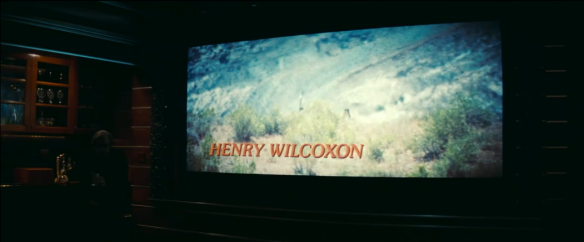 but then it seems that, ignoring for now QT’s self referential tweak at Inglorious, maybe Rick was in a movie like Sinatra was in Von Ryan’s Express (1964), which had a modern feel, but was strictly old Holly wood, that’s when he torches the Nazis, to be continued on this detail (I saw it in the theater, a Frank Sinatra movie).
but then it seems that, ignoring for now QT’s self referential tweak at Inglorious, maybe Rick was in a movie like Sinatra was in Von Ryan’s Express (1964), which had a modern feel, but was strictly old Holly wood, that’s when he torches the Nazis, to be continued on this detail (I saw it in the theater, a Frank Sinatra movie).
 either way, Rick is now doing villains on TV, which, he is told, is box office poison. He is also told that trying to look hip and so 60s in the rock post-Beatles scene only makes him ridiculous (I watched Hulabaloo slavishly, carefully recording in a notebook every major act I saw on it, I loved it, but I was 13).
either way, Rick is now doing villains on TV, which, he is told, is box office poison. He is also told that trying to look hip and so 60s in the rock post-Beatles scene only makes him ridiculous (I watched Hulabaloo slavishly, carefully recording in a notebook every major act I saw on it, I loved it, but I was 13).
 then 5) Rick has an all but complete time-lapse breakdown, as not only is the message he received that he is a has-been, but against that billboard of the “oldest” restaurant of old Hollywood, that makes the whoosh of depression even more vertiginous, so this is a 1969-plunging back to 1949 nightmare (Tarantino makes extensive use of signage, about that in a bit).
then 5) Rick has an all but complete time-lapse breakdown, as not only is the message he received that he is a has-been, but against that billboard of the “oldest” restaurant of old Hollywood, that makes the whoosh of depression even more vertiginous, so this is a 1969-plunging back to 1949 nightmare (Tarantino makes extensive use of signage, about that in a bit).
 then we return to both making do in 1969, but right away 6) we see the Manson girls dumpster diving before a Giant poster for Giant (1956)
then we return to both making do in 1969, but right away 6) we see the Manson girls dumpster diving before a Giant poster for Giant (1956)
 and as they walk it out, in 1969 from1956 one cannot help but think Tarantino held on to the haunted house
and as they walk it out, in 1969 from1956 one cannot help but think Tarantino held on to the haunted house
 to ping on an unacknowledged rrhexis of reference to Psycho (1960)
to ping on an unacknowledged rrhexis of reference to Psycho (1960)

to maybe, as above, whisper a little something along the lines of, what the hell happened to women? in reference to Elizabeth Taylor in her late prime.
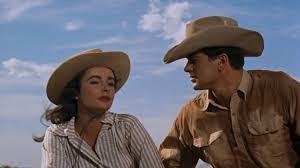
Then, 7), but really picking up on the time warp of the opening scenes, Rick becomes aware of the fact that he lives right next to Roman Polanski, so it is his 1969 versus their 1969 again
 then comes the tragic drive home by Cliff 8) where it is revealed he lives in a trailer way out in Panorama City, next to a drive in, playing Lady in Cement (1968), exactly the sort of movie Sinatra played in his second revival after Von Ryan’s Express, I think unwatchable (it’s on youtube); but for that, drive-in culture is definitely late 1950s, and so Cliff also lives in a 1959-1969 time warp, with a nice wobble here, (the curious thing is that in light of the covid outbreak, which has now doubled up to return big time to California, there is some return of the drive-in after going obsolete in the later 60s (I never went to one)). In movie lore, the end of the drive-ins, and the end of “old” horror, that is, Corman Victorian-story horror, for new “horrors of the world now” horror, which is not exactly true, happened in Bogdonavich’s Targets (1968), using old clips from Karloff in The Terror (1963), as a movie shown in a driven in which lets the shooter shoot
then comes the tragic drive home by Cliff 8) where it is revealed he lives in a trailer way out in Panorama City, next to a drive in, playing Lady in Cement (1968), exactly the sort of movie Sinatra played in his second revival after Von Ryan’s Express, I think unwatchable (it’s on youtube); but for that, drive-in culture is definitely late 1950s, and so Cliff also lives in a 1959-1969 time warp, with a nice wobble here, (the curious thing is that in light of the covid outbreak, which has now doubled up to return big time to California, there is some return of the drive-in after going obsolete in the later 60s (I never went to one)). In movie lore, the end of the drive-ins, and the end of “old” horror, that is, Corman Victorian-story horror, for new “horrors of the world now” horror, which is not exactly true, happened in Bogdonavich’s Targets (1968), using old clips from Karloff in The Terror (1963), as a movie shown in a driven in which lets the shooter shoot

the camera even does a beautiful flyover of the drive-in,
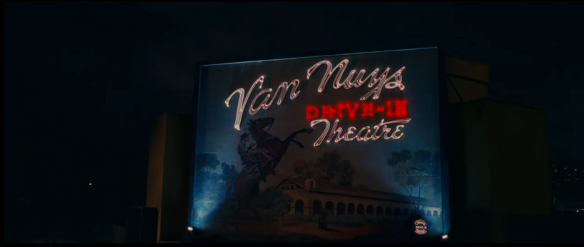 to come over the neon rainbow
to come over the neon rainbow
 into the blindspot in time which rests at the top of many a leap out of nightmares awoken from.
into the blindspot in time which rests at the top of many a leap out of nightmares awoken from.
 for it to then blind us,
for it to then blind us,
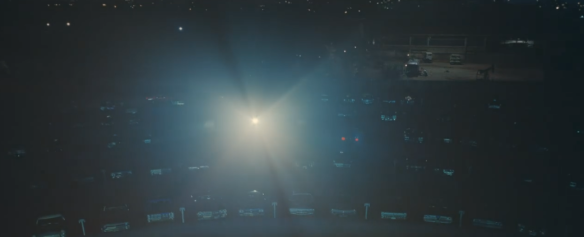 to bounce us into a white out, in ambient space
to bounce us into a white out, in ambient space
 showing that Cliff lives very far away, indeed, from the movie (but the chair indicates he watches them from afar for free).
showing that Cliff lives very far away, indeed, from the movie (but the chair indicates he watches them from afar for free).
 in his little end of the world. His trailer life is all TV all the time, in this case 9) I think Tarantino is meant to show us the flameout nature of fame, this is Robert Goulet singing MacArthur Park, Jimmy Webb’s anthem of almost-Beethoven by which crooners pompously entertained higher than middle culture in the 60s, so pretentious now (Richard Harris, no less, did the record hit; donna Summers did the best version).
in his little end of the world. His trailer life is all TV all the time, in this case 9) I think Tarantino is meant to show us the flameout nature of fame, this is Robert Goulet singing MacArthur Park, Jimmy Webb’s anthem of almost-Beethoven by which crooners pompously entertained higher than middle culture in the 60s, so pretentious now (Richard Harris, no less, did the record hit; donna Summers did the best version).
 then he’s got Mannix on, never watched a single episode, this was for “grown ups” in the 60s, can’t even tell you the actor’s name, ok, Mike Connors
then he’s got Mannix on, never watched a single episode, this was for “grown ups” in the 60s, can’t even tell you the actor’s name, ok, Mike Connors
 then there is Three in the Attic, a “new” film for young people, “relevant”
then there is Three in the Attic, a “new” film for young people, “relevant”
 (I watched it, see part 2).
(I watched it, see part 2).
 other than that his life is in tatters, a series of make-do routine actions depleted by routine.
other than that his life is in tatters, a series of make-do routine actions depleted by routine.
 he seems, indeed, to have a housewife’s life, in the 60s, we were so sold on the New TV Season that we eagerly consumed all of it, excited to see new offerings, the New Fall Season TV Guide we would cut out the pictures and put them all in a scrapbook, alerting us (how different now, with one million unwatched series to stream).
he seems, indeed, to have a housewife’s life, in the 60s, we were so sold on the New TV Season that we eagerly consumed all of it, excited to see new offerings, the New Fall Season TV Guide we would cut out the pictures and put them all in a scrapbook, alerting us (how different now, with one million unwatched series to stream).
 but his tastes were formed in the 50s, Ann Francis
but his tastes were formed in the 50s, Ann Francis
 it took me five seconds to google another photo from this pin up shoot, called busty or buxom.
it took me five seconds to google another photo from this pin up shoot, called busty or buxom.
 she was, of course, in Forbidden Planet (1956) when as the sexy daughter of Walter Pigeon, pre-funny days Leslie Nielsen basically balled her out for walking around half naked because she is making all his men, who haven’t seen a woman in a year (the “no women” excuse) want to gang rape her.
she was, of course, in Forbidden Planet (1956) when as the sexy daughter of Walter Pigeon, pre-funny days Leslie Nielsen basically balled her out for walking around half naked because she is making all his men, who haven’t seen a woman in a year (the “no women” excuse) want to gang rape her.
 but, that’s all 9) cliff is his particular time-warp wobble. By contrast, Rick 10) lives in more luxury, but the posters, which are all over the movie (about these in a bit), are old too, so 10) is a revisiting of earlier days.
but, that’s all 9) cliff is his particular time-warp wobble. By contrast, Rick 10) lives in more luxury, but the posters, which are all over the movie (about these in a bit), are old too, so 10) is a revisiting of earlier days.
 fading fame is also evinced by souvenir mugs with his cowboy image on them, which he collects.
fading fame is also evinced by souvenir mugs with his cowboy image on them, which he collects.
 then old rat pack rituals, love the glass with the red pheasant with gold wings on it.
then old rat pack rituals, love the glass with the red pheasant with gold wings on it.
 I guess it was a thing
I guess it was a thing

I did a post on it. What could it mean? One, of late, in a time, June, 2020, when people are ping-ponging politics-as-usual with a grave pandemic, things have gone hippalektryonic, that is, a horse-headed rooster whose composite nature captures he spindly shouty sharing nature of the nonmaskwearing person (related to a Karen with her “Can I talk to the manager” haircut). I am looking to see other ‘monsters,” or grylloi. Two, a red herring, of course, is a character in a mystery on whom suspicion falls for a good long time, only for it to turn out he was a misdirection, it wasn’t him. Then, I have found in movies, a Wrongful Blue Boy, and then paired with a Rightful Red Herring, classic case of this joining is Black Christmas (1974), Keir dullea is not the killer, but takes the blame; the woman who kills him gets off, even though she was the red herring. What would a red gold winged pheasant, a Chryskokkopterophasian,represent? he’s guilty, but of not paying attention, of getting caught up in the shtick of it, then letting time get away from him, but he’s not guilty, because most people do. So, vis-a-vis time he is the guy who lets himself become old hat, a chryskokkopteronphasian (more on this later). Since this might be a kind of sleep, it may play into the bigger plan, is he too a Seventh Sleeper?

highballs, cocktail hour, it was a custom of the World War Ii crowd

to be continued.